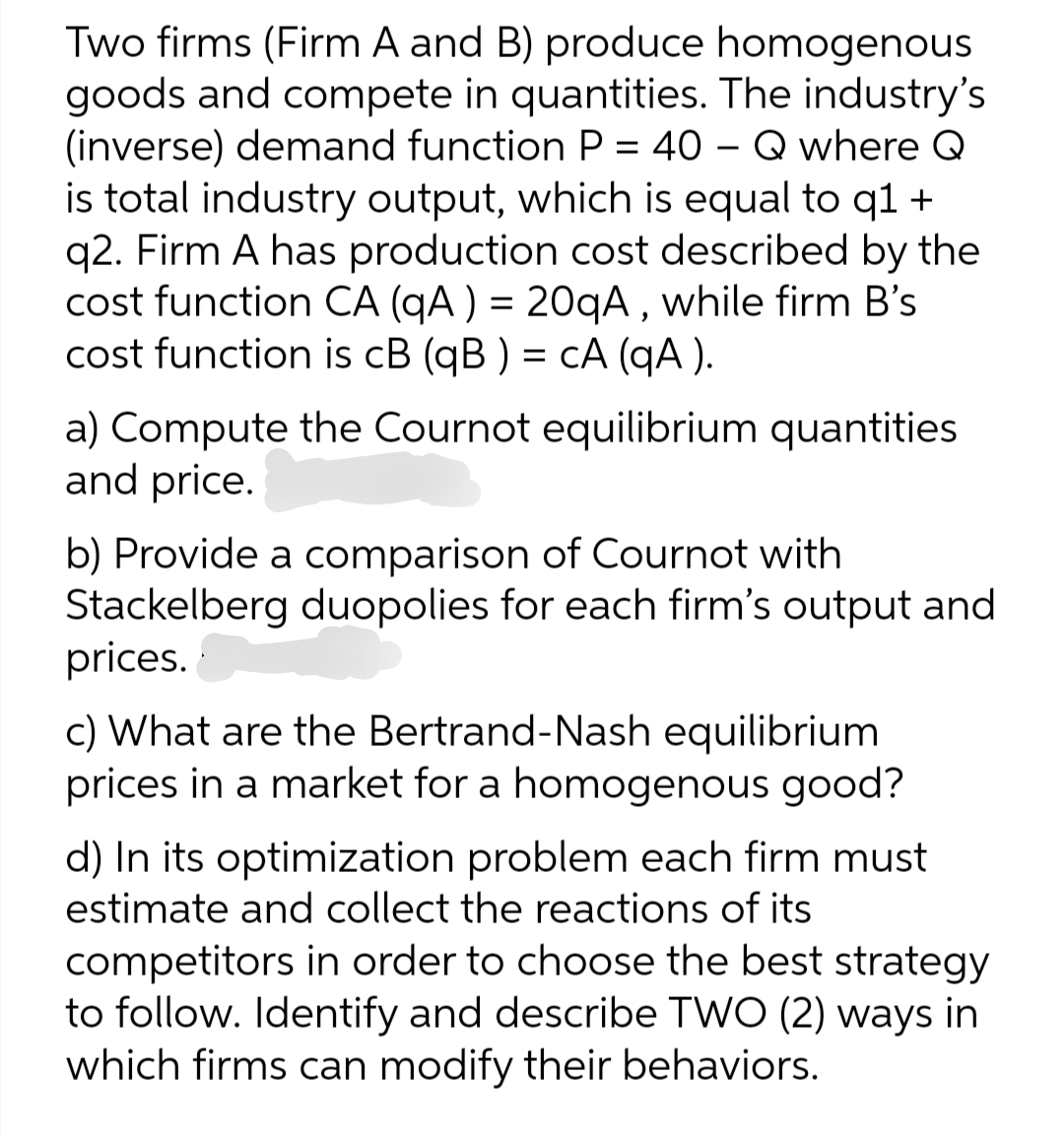Two firms (Firm A and B) produce homogenous goods and compete in quantities. The industry's (inverse) demand function P = 40 – Q where Q is total industry output, which is equal to q1 + q2. Firm A has production cost described by the cost function CA (qA ) = 20qA , while firm B's cost function is cB (qB ) = cA (qA ). %3D a) Compute the Cournot equilibrium quantities and price. b) Provide a comparison of Cournot with Stackelberg duopolies for each firm's output and prices. c) What are the Bertrand-Nash equilibrium prices in a market for a homogenous good?
Two firms (Firm A and B) produce homogenous goods and compete in quantities. The industry's (inverse) demand function P = 40 – Q where Q is total industry output, which is equal to q1 + q2. Firm A has production cost described by the cost function CA (qA ) = 20qA , while firm B's cost function is cB (qB ) = cA (qA ). %3D a) Compute the Cournot equilibrium quantities and price. b) Provide a comparison of Cournot with Stackelberg duopolies for each firm's output and prices. c) What are the Bertrand-Nash equilibrium prices in a market for a homogenous good?
Chapter15: Imperfect Competition
Section: Chapter Questions
Problem 15.4P
Related questions
Question
3

Transcribed Image Text:Two firms (Firm A and B) produce homogenous
goods and compete in quantities. The industry's
(inverse) demand function P = 40 – Q where Q
is total industry output, which is equal to q1 +
q2. Firm A has production cost described by the
cost function CA (gA ) = 20gA , while firm B's
cost function is cB (qB ) = cA (qA ).
%3|
%3D
a) Compute the Cournot equilibrium quantities
and price.
b) Provide a comparison of Cournot with
Stackelberg duopolies for each firm's output and
prices.
c) What are the Bertrand-Nash equilibrium
prices in a market for a homogenous good?
d) In its optimization problem each firm must
estimate and collect the reactions of its
competitors in order to choose the best strategy
to follow. Identify and describe TWO (2) ways in
which firms can modify their behaviors.
Expert Solution
This question has been solved!
Explore an expertly crafted, step-by-step solution for a thorough understanding of key concepts.
This is a popular solution!
Trending now
This is a popular solution!
Step by step
Solved in 3 steps with 5 images

Knowledge Booster
Learn more about
Need a deep-dive on the concept behind this application? Look no further. Learn more about this topic, economics and related others by exploring similar questions and additional content below.Recommended textbooks for you


Survey of Economics (MindTap Course List)
Economics
ISBN:
9781305260948
Author:
Irvin B. Tucker
Publisher:
Cengage Learning

Managerial Economics: Applications, Strategies an…
Economics
ISBN:
9781305506381
Author:
James R. McGuigan, R. Charles Moyer, Frederick H.deB. Harris
Publisher:
Cengage Learning


Survey of Economics (MindTap Course List)
Economics
ISBN:
9781305260948
Author:
Irvin B. Tucker
Publisher:
Cengage Learning

Managerial Economics: Applications, Strategies an…
Economics
ISBN:
9781305506381
Author:
James R. McGuigan, R. Charles Moyer, Frederick H.deB. Harris
Publisher:
Cengage Learning


